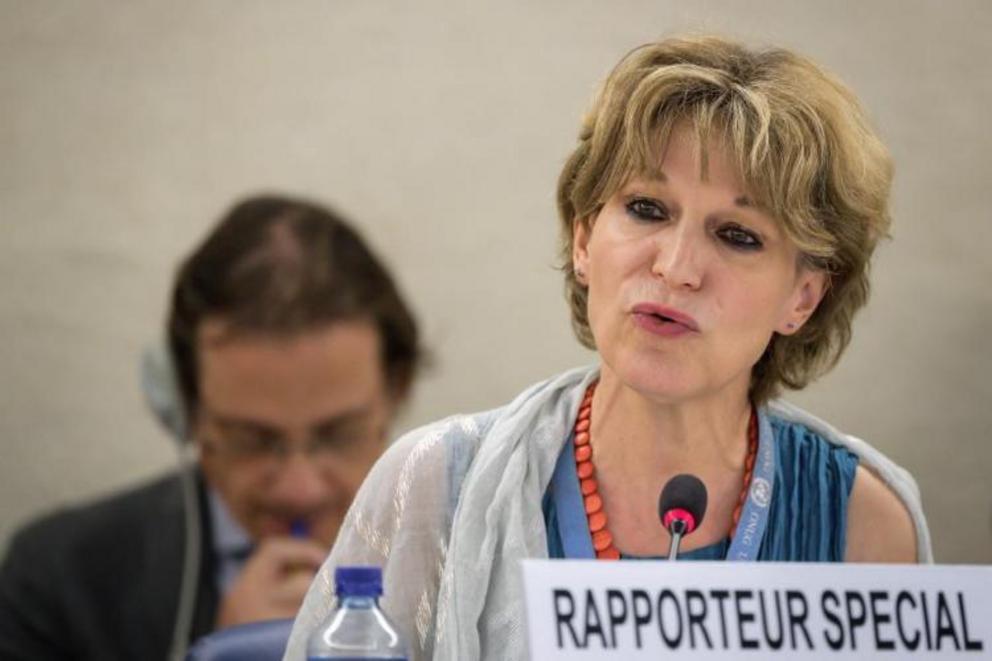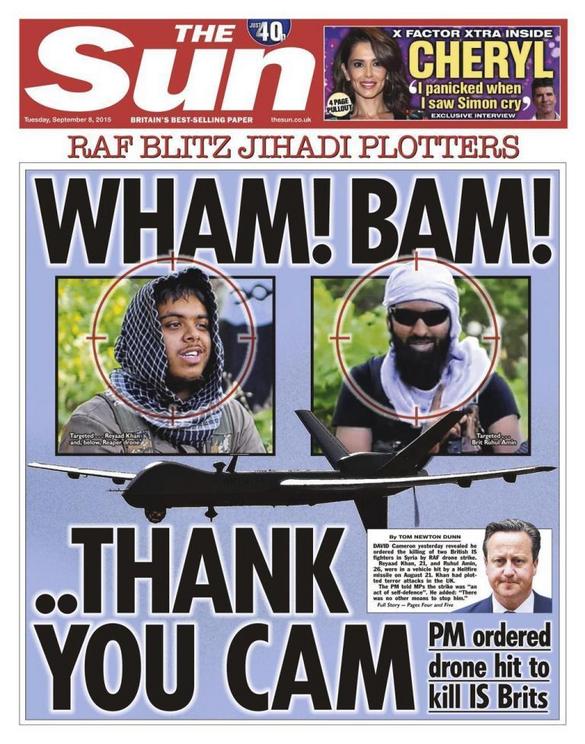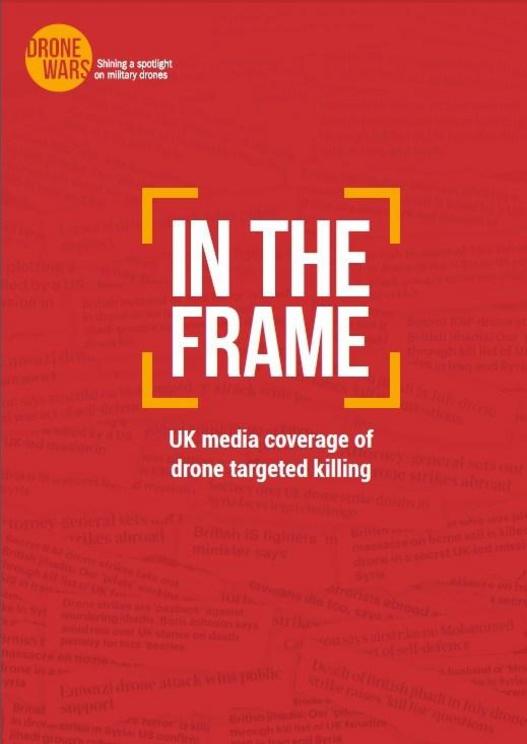New UN Special Rapporteur report on armed drones
... and targeted killing – its relevance for the UK

Agnes Callamard, Special Rapporteur on extrajudicial, summary or arbitrary executions
Agnes Callamard, the Special Rapporteur on extrajudicial, summary or arbitrary executions, has produced a new report on armed drones and targeted killing for the UN Human Rights Council. The report follows up and adds to two previous reports by her predecessors which we reported on at the time here (2010) and here (2014). While reading the full report is recommended, here is our summary and how it speaks to UK drone operations.
Focused on the use of armed drones in particular for targeted killings, the report lambasts the silence of States and international institutions in response to the damage being done by their increasing use:
“The vast majority of targeted killings by drones are subjected to little public scrutiny at either national or international levels. And yet, drone technologies and drone attacks generate fundamental challenges to international legal standards, the prohibition against arbitrary killings and the lawful limitations on permissible use of force, and the very institutions established to safeguard peace and security. [Para 1]
While the report argues, as previous Special Rapporteurs have emphasised, drones are not the only means by which targeted killings are being carried out, nevertheless
“Drones are a lightning rod for key questions about protection of the right to life in conflicts, asymmetrical warfare, counter-terrorism operations, and so-called peace situations. With their lot of unlawful deaths and arbitrary killings, they are also revealing of the severe failures of national and international institutions mandated to protect human rights, democracy, peace and security. [Para 6]
While focused primarily on issues raised by the increasing use of armed drones on international law, the report begins with a helpful review of the proliferation of armed drones over the past five years, and also examines what it calls ‘the myth’ of the surgical strike.

Tabloids celebrated UK drone targeted killings
The report then addresses what has now become a real problem here in the UK with the refusal of our government to detail where it is now deploying armed drones – the absence of transparency and accountability (see for example: ‘Ministers refuse to reveal target of new RAF killer drone missions‘) . In a key paragraph on this aspect the report states:
Drones sit at the intersection of several oversight regimes, but, being an intelligence asset, they somehow fall between them. With few to no risks involved for those directing or operating drones, including little risk of legal accountability, “the typical decision-making barriers to the use of force become eroded … because they do not attract ‘the public scrutiny that a troop deployment invites’”, as then US President Barrack Obama conceded in May 2013 . In general, at the domestic level, there seems to be many loopholes by which to avoid scrutiny, not the least because the matter can fall within the remit of many agencies but under the responsibility of none. [Para 24]
Responding to the unwillingness of courts to address the lack of accountability in response to judicial action, Agnes Callamard argues that:
“a blanket denial of justiciability over the extra territorial use of lethal force cannot be reconciled with recognized principles of international law, treaties, conventions, and protocols, and violates the rights to life and to a remedy. [Para 27]
The report then goes on to examine in detail international law arguments surrounding the use of drones for targeted killing. The report emphasises that to be lawful “a drone strike must satisfy the legal requirements under all applicable international legal regimes: the law regulating inter-state use of force (jus ad bellum); international humanitarian law (IHL) and international human rights law (IHRL).” [Para 30]
After summarising the way in which international law limits the use of armed force, particularly in the area of self-defence, the report sets out the ways that “a small number of influential States have sought to expand those understandings despite the large body of opinion and State practice that oppose them.” She then goes on very directly to say “It is the view of the Special Rapporteur that these recent minority interpretations create troubling legal “distortions”. [Para 53]
Callamard sets out very clearly what these distortions are. Firstly, that of erosion of the concept of imminence in relation to responding to a threat under self-defence rules (something that former UK attorney general Jeremy Wright argued when in office); secondly in relation to geography and the so-called ‘boundary-less’ idea of war; and thirdly the erosion of sovereignty with the idea of States being ‘unable or unwilling’ to challenge threats of non-state groups.

Remains of vehicle following US drone strike on Iranian General Qassem Soleimani outside Baghdad airport
The targeted killing of General Quassem Soleimani (which the report addresses in an important and detailed 18-page appendix) is also highlighted as a significant way in which drones and ‘the war on terror’ are eroding international law norms:
“The full implications of the drone targeted killing of a State actor for future conduct are unknown at this point. What is known is that legal distortions of the last twenty years, coupled with the technological prowess of the “second drone age”, have enabled a substantial increase in applications of the use of force: low-intensity conflicts are drawn-out with few if any geographical or temporal boundaries. The targeted killing of a State actor in a third State has brought “the signature technique of the so-called “war on terror” into the context of inter-state relations,” and highlighted the real risks that the expansion of the “war on terror” doctrine poses to international peace. [Para 62]
Paraphrasing Marko Milanovic in a startling turn of phrase, the report argues that “the targeted killing of General Soleimani, coming in the wake of 20 years of distortions of international law, and repeated massive violations of humanitarian law, is not just a slippery slope. It is a cliff.”
The report concludes that what is especially troubling is:
“the absence of public discussion about the ethics, legality, and effectiveness of the “decapitation” strategy at the heart of drones targeted killings… in terms of a long-term vision for the sustainable protection of human lives and global peace. Instead, war has been normalized as the legitimate and necessary companion to “peace”, not as its opposite we must do all that we can to resist. [Para 84]
Relevance to the UK
Agnes Callamard is strongly arguing that the international community should respond to the ‘small number of states’ that are distorting international law to widen the circumstances when preemptive drone targeted killing can be seen as lawful. She also challenges parliaments and legislators to step-up when executive deny transparency or oversight over drone operation. Although never directly accusing the US or UK, it is clear who she is referring to. It was (then) UK Attorney General Jeremy Wright, who strongly argued for a drastic change to the understanding of ‘imminence’ in relation to undertaking lethal action under right of self defence, while the investigation into the UK’s drone targeted killing of Reyaad Khan by the parliamentary Joint Human Rights Committee and the Intelligence and Security Committee were both frustrated by narrow remits and refusal of the executive to share relevant information.

Framing narratives on drone targeted killing. Click to open report.
Related to this is what Agnes Callamard describes as “the absence of public discussion about the ethics, legality, and effectiveness” of drone targeted killing. Our report ‘In the Frame: UK media coverage of drone targeted killing‘ published in January 2020, argues that the UK government’s refusal to discuss key details or policy issues around these operations has helped to curtail media coverage and public debate, creating a climate where targeted killing has become normalised and accepted, eroding human rights norms.
A number of the Callamard report’s recommendations (below) are particularly relevant to the UK as one of the leading users of armed drones. We would very much endorse the calls for a UN inquiry into the use of drones for targeted killing; an annual report tracking drone strikes and casualties; and the establishment at the UN level of a multilateral process which included civil society groups and victims, to set standards on the use of armed drones.
However, at a time when the UK has taken a backward step in transparency over the use of drones – refusing to say where its drones are currently operating – recommendations around parliaments taking greater steps to ensure oversight and transparency are particularly relevant.
Callamard Recommendations
The report ends by making a number of recommendations of which we highlight the following (although, again, worth reading the full report)
- The UN Secretary General should set up international inquiries or fact-finding missions to investigate drones’ targeted killings.
- The OHCHR should produce a yearly report tracking drones’ strikes and casualties for discussion by the Human Rights Council.
- At the level of the UN, Member States should:
- Establish a transparent multilateral process for the development of robust standards in the use of drones;
- Failing b), like-minded States should establish a group of experts to develop such standards as part of a time-bound forum for States, academics, and civil society to identify and strengthen legal norms and accountability mechanisms;
- Invite experts or institutions to publicly classify armed conflicts and situations that may have triggered, or are evolving rapidly in the direction of, international or non-international armed conflicts;
- Support the UNSG Protection of Civilians Strategy by providing it a clear mandate, and adopting specific guidance on the use of explosive weapons in urban areas and human sufferings;
- Adopt a strong political declaration on Strengthening the Protection of Civilians from Humanitarian Harm arising from the use of Explosive Weapons in Populated Areas.
- States using armed drones should:
- When invoking Article 51, provide a thorough justification, including evidence of an ongoing or imminent attack and the proportionality of the measures to be taken in response;
- Set up a dedicated civilian casualty mitigation and investigation team with commensurate resources to understand the impact of drones’ operations and accurately record civilian harm;
- Robustly investigate allegations of civilians’ harms, including with external sources, and release data and findings.
- States assisting other States’ drones programmes should:
- Inform Parliament of any assistance arrangements;
- Establish a robust oversight framework to ensure the State is not complicit in unlawful actions and State officials criminally liable; Receipt of assurances on their own is not sufficient;
- In situations involving the use of force in countries with which the Host State is not in conflict, adherence to IHRL must be considered
- States that export armed drones’ technology should:
- Enact stricter controls on the transfer of military and dual-use drone technology and apply clear criteria to prevent irresponsible transfers;
- Include civilian protection and adherence to IHL for approval and continuance of support, sale and training on armed drones;
- Adopt a dedicated process of operational end-use monitoring to analyse the outcome of drones’ strikes and civilians’ impact.
- Parliaments should:
- Review procedures for parliamentary scrutiny and oversight, to identify and limit specific instances when the deployment of force may not be openly debated;
- Debate general policies on use of force, including for purposes of targeting killing, and particularly in instances when parliamentary approval has not been secured.
